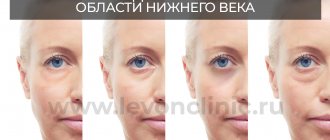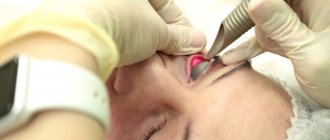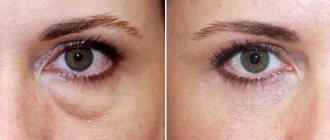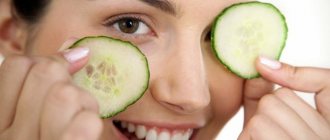Dark circles under the eyes
The most common cause of dark circles under the eyes is overwork and chronic lack of sleep. Lack of sleep makes the skin pale and dull, causing blood vessels to become more visible and purple shadows to appear under the eyes. Improper care (or lack of care) for the area around the eyes, poorly selected cosmetics, and the habit of rubbing your eyes with your hands also contribute to the appearance of dark circles under the eyes.
For many people, dark circles under the eyes are genetic. This may be due to light and thin skin of the infraorbital area, close proximity of blood vessels, excessive skin pigmentation, which are inherited and cause deep shadows under the eyes. Often, hereditary predisposition is aggravated by external causes: prolonged sitting in front of a computer monitor, bad habits (alcohol abuse, smoking, excessive tanning), unhealthy diet (consuming large amounts of caffeine, spicy seasonings, canned foods, etc.). Another factor in the appearance of dark circles under the eyes is the natural process of skin aging: with age, the skin becomes thin and flabby, and blood vessels appear much more clearly.
Dark circles under the eyes can be caused by dehydration and hypovitaminosis, which can be caused by strict diets. Sometimes shadows around the eyes appear as a result of sudden weight loss in a very short period of time - in these cases, the causes of dark circles under the eyes may lie in both loss of skin tone and metabolic disorders.
Often, dark circles under the eyes signal serious chronic diseases. A similar symptom can occur with renal, adrenal and heart failure, cholecystitis, cholelithiasis, helminthiasis, giardiasis, anemia, hypothyroidism, and diseases of the nervous system. In children, dark circles under the eyes can occur due to diseases of the nasopharynx (chronic tonsillitis), diseases of the teeth and gums, and vegetative-vascular dystonia. Allergic reactions (allergic rhinitis, conjunctivitis, hay fever), accompanied by dilation of blood vessels and increased permeability of their walls, can also give the skin around the eyes a dark tint.
It is believed that one or another shade of dark circles under the eyes can quite accurately indicate a disease of certain organs. Thus, blue-violet circles under the eyes occur due to circulatory problems; reddish ones are found in allergic and kidney diseases; yellow ones appear with problems with the liver and gall bladder; brownish ones may indicate chronic intoxication, helminthic infestation, etc.
Causes of age spots and dark circles under the eyes
There are 5 main causes of dark circles and age spots on the skin under the eyes , each of which requires its own set of measures to eliminate it.
Constitutional feature of the skin
Pigment spots often occur in those with ethnically dark skin.
Recommended : avoid direct sunlight, thinning skin and/or irritating cosmetics. There is a high risk of post-inflammatory pigmentation of the skin around the eyes.
Inflammatory skin diseases
This is a variant of post-inflammatory skin pigmentation, for example after atopic or contact dermatitis.
Recommended : hypoallergenic products for the skin around the eyes, specially developed taking into account skin sensitivity.
DermaQuest CBD Revitalizing Eye Cream - Hydrates, restores and rejuvenates the delicate and irritated skin around the eyes!
• Contains the innovative double action ingredient AquaCell :
- moisturizes the skin for 24 hours, eliminates negative symptoms of dryness and smoothes dry wrinkles;
- restores the skin’s own structures, which are responsible for filling cells with moisture – a long-term effect of compacting and hydrating the skin;
• Argan stem cells – activate the skin’s own stem cells, normalize collagen production and cell division – the skin becomes more elastic and toned;
• Additionally contains Cannabidiol - a plant extract, a “boom” of 2022 in cosmetology and medicine. Heals, restores normal structures and functions of the skin - against dryness, itching and irritation of the skin. Prevents the appearance of post-inflammatory pigment spots.
Benefits of CBD Eye Cream:
Comfort and effectiveness even for ultra-sensitive skin!
Natural, safe composition with 80% ingredients of natural origin!
Moisturizes, softens and soothes the delicate skin around the eyes!
Application:
▫ Apply daily morning and evening to clean skin
▫ For an anti-edematous effect, store the jar in the refrigerator door
Internal illnesses
Diseases that cause swelling, pigment deposition and age spots around the eyes:
- Low hemoglobin level;
- Iron-deficiency anemia;
- Kidney failure;
- Diseases of the heart or blood vessels.
Recommended : consult a doctor.
Vascular disorders in the skin around the eyes
Edema forms, plasma sweats and pigment is deposited into the surrounding tissue. Later pigment spots form.
- Visually: blueness under the eyes, age spots
- Absolutely physiological and not a pathology
Recommended: mask with makeup, use products with a vasoconstrictor effect and remove pigment from surrounding tissues.
An example of such a product is described below - this is EyeBright cream for eye care DermaQuest .
Age-related skin changes
Lack of collagen due to its destruction and insufficient synthesis leads to:
- dilation of blood vessels that become visible under the skin
- loose skin visually casts a shadow, simulating dark circles and age spots
Recommended: anti-aging products based on retinol: thickens and tightens the skin, normalizes pigment formation.
The skin around the eyes is delicate, a high percentage of retinol is not indicated for this area; it is necessary to start with low percentages (0.3 - 0.5%) and preparations containing gentle forms of retinoids, for example, retinaldehyde .
Causes of hyperpigmentation of facial skin
Melanin synthesis in the human body is controlled at the level of the brain and hormonal system. Based on this, we can identify the main causes of hyperpigmentation of facial skin:
- Excess solar exposure. Prolonged active uncontrolled tanning leads to cell damage and disruption of the protective function of the skin. As a result, melanocytes increase in size, produce more melanin and transport it faster to the surface of the skin.
- Hormonal disorders. Hormones of the sex glands, adrenal glands and thyroid glands have a direct effect on the production of melanin. When the hormonal balance is disrupted, the amount of pigment in the skin can sharply increase or decrease. This can be caused by endocrine diseases, pregnancy, menopause, or taking hormonal contraceptives.
- Taking medications that increase photosensitivity. Medicines for hypertension, some antibiotics and herbal teas can reduce the protective function of the skin and pathologically increase the production of melanin under the influence of ultraviolet rays.
- Nervous shocks and extreme temperature conditions. These factors cause a sharp decrease in skin immunity, and, as a result, melanocytes act to protect the skin. Melanin takes on the role of absorbing radiation and neutralizing harmful free radicals.
- Dermatological diseases. Psoriasis, eczema, dermatitis, acne are accompanied by inflammation and frequent trauma to the skin, which also stimulates pigmentation.
Is it possible to determine their cause by the color of dark circles under the eyes?
Circles under the eyes, depending on the cause, have different shades - blue, brown, yellow, reddish.
If the circles have a bluish tint, this may indicate:
- Disorders of the digestive system;
- Impaired functioning of the heart and blood circulation;
- Fatigue;
- Sleep disturbances;
- Overwork due to working at the computer and frequent use of gadgets.
Yellowish circles indicate:
- An increase in the amount of bilirubin due to impaired functioning of the liver and gallbladder;
- Improper lifestyle, smoking, alcohol abuse;
- Unbalanced diet;
- Experienced stressful conditions.
A red tint indicates:
- Kidney disease (circles are associated with swelling);
- Allergic manifestations;
- Lack of exposure to fresh air;
- Sensitive skin;
- Experienced stressful conditions;
- Inflammatory processes in the eyes.
If the circles are brown, this may indicate:
- Severe fatigue;
- Unbalanced diet;
- Side effects of certain medications;
- Hormonal imbalance;
- Endocrine imbalance;
- Impaired functioning of the circulatory system, thick blood;
- Lack of vitamins and microelements.
It is important to note that the grayish-brown circles are most noticeable in the late afternoon. Regular overwork, chronic stress, general fatigue, and computer-related work provoke stagnation of blood in the capillaries. Excess adrenaline in it provokes vasoconstriction.
Treatment
If internal diseases are excluded, then we are talking about a cosmetic defect, which is a consequence of an unhealthy lifestyle and genetic predisposition. The most popular and effective treatments for dark circles under the eyes are as follows.
- Mesotherapy Preference is given to meso-cocktails containing ascorbic, phytic and kojic acids, and arbutin. A course of 6-10 procedures with an interval of 1 week.
- Bioreparation with vitamin C The combination of hyaluronic acid and vitamin C effectively moisturizes and brightens the skin around the eyes. A course of 2-4 procedures with an interval of 2 weeks.
- Plasmolifting By restoring metabolic processes, normalizing tissue respiration, and improving microcirculation, local skin immunity is activated. A course of 4-6 procedures with an interval of 1 week.
- Biorevitalization The skin under the eyes reacts especially acutely to dehydration and often looks unaesthetic due to dryness, creating the effect of “tired eyes”. A course of 2-4 procedures with an interval of 2 weeks.
- Contour plastic With closely spaced, “translucent” vessels, filler creates an additional layer between the skin and the underlying vessels, thereby making them less noticeable. Additionally, the effect of leveling the nasolacrimal groove is achieved.
- Laser peeling The essence of laser resurfacing is to remove the upper layers of the skin, its renewal and rejuvenation. A course of 2-5 procedures with an interval of 1 month.
Why does hyperpigmentation appear on the face?
The pigment melanin is always present in the skin. It provides skin color and protection from harmful ultraviolet radiation to which we are exposed during sun exposure. Pigment-secreting melanocyte cells are sensitive to sunlight, producing pigment particles into the layers of the epidermis. There, melanin should be distributed in an even layer and prevent radiation from damaging skin cells. But often pigmented cells accumulate randomly due to uncontrolled sun exposure.
The skin on the face is the area that is most susceptible to external factors. This is why hyperpigmentation of facial skin is so common. In addition, the thickness of the skin on the face is uneven, which also causes the rapid appearance of pigment on its surface. It is worth noting that the facial part of the skull contains many branches of large blood and lymphatic vessels, as well as nerves. This explains the display of internal problems of the body on the face.
What causes such a cosmetic defect?
The skin around the eyes is very thin, sensitive and delicate. The collagen fibers in it are arranged in a mesh pattern, and this contributes to its increased extensibility. Due to facial activity, this area of the face is constantly in motion and is prone to swelling. Immediately under the skin there are blood vessels that are translucent due to the small thickness of the skin and the accumulation of blood in them with an insufficient amount of oxygen.
As a result, dark circles appear under the eyes. This effect is further enhanced by the fact that the eyes are located in the area of the orbital sockets and the manifestation of shadows intensifies.
Gutsenko Liliya Anatolevna
Cosmetologist
With age, when the body's metabolism slows down, the problem of dark circles becomes even worse. Blood can stagnate in the vessels, which can lead to a lack of oxygen. In addition, the skin loses collagen and elastin and becomes even thinner and more stretchy.











